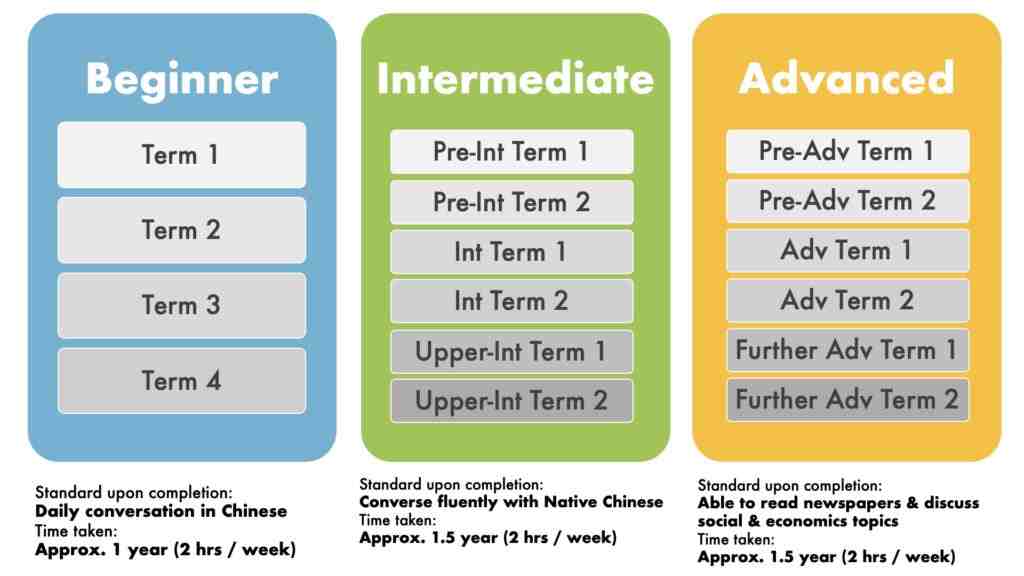Frequently Asked Questions
Course & Language related questions to clarify your doubts
Course Related Questions
We have 2 broad courses:
- Conversational Chinese
- Structured & Systematic Curriculum
- Learn practical everyday Chinese
- Suitable for complete beginners
- Business Chinese
- Highly customised curriculum for your industry
- Familiarise yourself with Chinese business etiquette and culture
- Suitable for intermediate and advanced learners
Our Conversational Chinese – Beginner level is designed with our complete beginner learners in mind. You may join our Beginner Chinese from Term 1 onwards and progress from there to Term 2,3 & 4 before moving on to Intermediate and Advanced Level.
You can enroll yourself in our Chinese courses here.
We have 3 types of courses from Beginner to Advanced levels:
- Public Group
- 12 x 2 hours weekly lessons
- Held at Elite @ Bugis & Elite @ Tanjong Pagar
- Class size 4-8 pax
- Private 1-1
- Highly customised lessons
- Flexible scheduling according to your preference
- Flexible locations (either at our centres, at your preferred venue, or online)
- Corporate Group
- Highly customised solution for your industry
- Qualified and experienced native trainer with industrial experiences
- Lesson conducted at company premises
For more information about our Private 1-1 and Corporate Group courses, please contact our course manager at 9799 5377 (call or WhatsApp) or submit an online form.
There are 3 ways to do make up lessons:
- Utilize on your class’s FOC make-up hours. Arrange directly with the trainer. Total = 3 hours for the whole class for the whole term (to be split into 6 x 30 min sessions & distributed fairly among all the students). Advisable to do it before or after the actual class.
- Sit in another class for a full 2-hour make up (subject to availability). State which lesson you want to do make up to the course manager and he/she will arrange.
- Arrange for a private 1-1 make up with your trainer at a highly discounted rate of $35/hr if you need longer make up sessions. Arrange & pass the fee directly with the trainer.
It depends on how hardworking you are. Some can progress very fast and some progress slowly. Typically, our students will be able to hold simple & basic daily conversation after the completion of Term 2 (i.e. ~ 48 hours).
Language is something that will take time & effort to acquire. You need to be patient to see progress.
Our class is usually once a week. However, if the whole class agreed & classrooms are available, we can have classes for 2 times per week. We are planning to introduce more intensive class in the near future.
Yes, upon min. attendance of 70%, you will receive an e-certificate of completion from us. Hard copy certificate can be requested & collected from our centre for face-to-face students.
See our sample cert here.
Yes, you can make payment on a term by term basis. Each term is minimum 3 months. Course fee for the term have to be paid in full before the commencement of the course. Otherwise, you may wish to check directly with your banks to arrange for instalment payments.
Yes, upon enrolment, you will receive an electronic invoice. You can follow the instruction on the invoice to make payment, which include credit card mode. Please note that there is a 4% transaction fee for this mode of payment. As much as possible, we prefer payment to be made by bank transfer or PayNow, which do not have transaction fee.
Yes, you can make arrangement with us to make the cash payment before the start of the first lesson. However, as much as possible, we prefer payment to be made by bank transfer or PayNow.
Beginner Chinese Term 1 course is $500 nett (Face to Face lesson) and $400 nett (Online lesson).
All Beginner level fees are $500 nett (Face to Face lesson) and $400 nett (Online lesson).
Unlike some training providers in Singapore, we do not charge any extra fees for registration and materials. All our course fee is NETT price inclusive of textbook, supplementary learning materials, worksheets, academic services and e-learning resources.
True to our people-centric believe, we keep our class size small for effective teaching & learning. Our class size is between 4-8 pax.
At the moment, our courses are not Skillsfuture claimable.
Please check out this link: https://www.elitelinguistic.com/courses/#private
We have 3 locations in Singapore, serving people in the CBD, East & West. They are:
- Elite @ Bugis
- Elite @ Tanjong Pagar
All are within 5 minutes walking distance to MRT. Check our contact page for detailed address & map.
Our students at Elite are all adults learners coming from different industries and background, including business owners, professionals, managers, executives, or even government officials from different regions of the world.
Language Related Questions
Learning a new language usually involves spending a lot of time and energy. Are there any shortcuts?
Mastering a new language really involves a lot of hard work and no shortcuts, but our courses will provide you with an enjoyable and systematic learning environment to achieve the desired results. You just need to remember this three words in mind: Passion, Practice and Patience.
Traditional Chinese and simplified Chinese are two writing systems but with the same pronunciation. The former is used in Taiwan, Hong Kong and some regions outside Mainland China and the latter is mainly used in People’s Republic of China, Malaysia and Singapore. See the history development of the 2 character versions and the debate over it from: https://en.wikipedia.org/wiki/Debate_on_traditional_and_simplified_Chinese_characters
Of course, it’s the most enjoyable way to study a new language, especially for intermediate and advanced level students. However, just remember to use the version with English subtibles.
Chinese language has plenty of characters possessing not only one pronunciation, which is called polyphone. Different pronunciations indicate different meanings, its location in a speech and the usage.
For example: 好 can be pronounced as Hǎo or Hào.
Hǎo can mean: good, easy, well, very, cheer, regards; Hào can mean: like, be easy.
The four tones are specialized features of the spoken Chinese language. Those who are used to alphabetic scripts cannot accept them easily. However, the Chinese people use the four tones to clarify the meaning of the words. Since many characters have the same sound, tones are used to differentiate words from each other. Of course, there are also characters that have exactly the same sound & tone.
See the difference of 4 tones through this video clip: https://www.youtube.com/watch?v=3wV8B4bx1lM
Why must we study Chinese characters? Why can't we use Hanyu Pinyin as the Chinese written language?
Hanyu Pinyin in only the phonetic system for Chinese characters. It is only a tool to help you pronounce the characters correctly. It definitely cannot be used as a substitute for the Chinese characters. They play different roles in the Chinese language. If you really read any newspaper, reports or books, you will notice Pinyin cannot be found anywhere. You can only find Chinese characters in Chinese media.
Read about the interesting history of Pinyin here: https://www.theguardian.com/world/2008/feb/21/china
Although Chinese characters were derived from pictures, it has a very logical and systematic structure which is closely related to its functional meaning. Before learning and practicing Chinese handwriting, one must have some idea of the characteristics of Chinese characters because handwriting is based on the characters themselves. Only after understanding the principles of the structure in Chinese characters can one know how to write them.
A Chinese character is usually composed of a group of lines or points, which may form a single key component in a character; various components then combine together to form a character. Therefore, all Chinese characters are composed of points and lines drawn in different angles. Each character has its own form, meaning and pronunciation.
There are six categories in which Chinese characters belong to:
1. Ideographs: In this category, each character can be defined by its appearance. For example:
2. Picture Characters: In this category, each character looks like a physical object. For example:
3. Implied Meaning: In this category, each character is made up of two or more meaningful parts, which are logically combined together. For example:
4. Combination of Shape and Sound: In this category, a character is made up of two parts, one to indicate the meaning of the character and the other for its pronunciation. For example:
5. Transition: In this category, each character is usually transformed into another character by changing its basic component(s). For example:
6. Assumption: In this category, each character is created according to the meaning of the original character, rather than by referring to the appearance or pronunciation of the original. For example:
(By Professor Wu Heng, translated by Harold L.K. Siu, Chinese Art (Taipei: Youth Cultural Enterprises Co., Ltd., 1985)).
Ans: There are different studying systems and patterns for kids and adults, so it’s not recommended for you and your kids to study together. Like Chinese courses in other language schools, our courses are designed for adults, especially professionals.
Don’t worry, you are not alone, as this happens quite often to most of the people learning Chinese. The only solution is to keep it up, listen more, try to speak everyday and after a period of time, you will get used to it. Phrases in the textbooks help you to start, but you should keep it aside and increase your practice in real life conversation once you have mastered the vocabulary and sentence structures.
Any other questions, please contact our course manager at 9799 5377 (call or WhatsApp) or submit your question online. Thank you.









